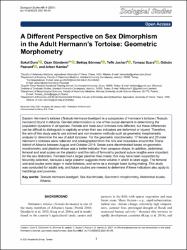| dc.contributor.author | Duro, Sokol | |
| dc.contributor.author | Gündemir, Ozan | |
| dc.contributor.author | Sönmez, Bektaş | |
| dc.contributor.author | Jashari, Tefik | |
| dc.contributor.author | Szara, Tomasz | |
| dc.contributor.author | Pazvant, Gülsün | |
| dc.contributor.author | Kambo, Arben | |
| dc.date.accessioned | 2022-05-10T06:00:23Z | |
| dc.date.available | 2022-05-10T06:00:23Z | |
| dc.date.issued | 18 March 2021 | tr |
| dc.identifier.citation | Duro S, Gündemir O, Sönmez B, Jashari T, Szara T, Pazvant G, Kambo A. 2021. A different perspective on sex dimorphism in the adult Hermann’s tortoise: geometric morphometry. Zool Stud 60:9. doi:10.6620/ZS.2021.60-09. | tr |
| dc.identifier.uri | https://hdl.handle.net/20.500.12418/12689 | |
| dc.description.abstract | Eastern Hermann’s tortoise (Testudo hermanni boettgeri) is a subspecies of Hermann’s tortoise (Testudo
hermanni) found in Albania. Gender determination is one of the crucial elements in determining the
population dynamics in all species. Female and male adult tortoises look different, but these differences
can be difficult to distinguish in captivity or when their sex indicators are deformed or injured. Therefore,
the aim of this study was to use indirect and non-invasive methods such as geometric morphometric
analysis to determine the sex of adult tortoises. For the geometric morphometry, 17 female and 23 male
Hermann’s tortoises were collected and photographed from the hills and mountains around the Tirana
district of Albania between August and October 2019. Sexes were discriminated based on geometric
morphometry, and plastron shape was a better indicator than carapace shape. In addition, abdominal,
femoral and anal scutes on the plastron and the ratio of femoral to pectoral suture lengths were important
for the sex distinction. Females had a larger plastron than males; this may have been supported by
fecundity selection, because a large plastron suggests more volume in which to store eggs. The femoral
and anal scutes were larger in male tortoises, and serve as a stronger base during mating. This study
was conducted for adults only, and future studies are needed to determine if these indicators also apply to
hatchlings and juveniles. | tr |
| dc.language.iso | eng | tr |
| dc.relation.isversionof | 10.6620/ZS.2021.60-09. | tr |
| dc.rights | info:eu-repo/semantics/openAccess | tr |
| dc.subject | Testudo hermanni boettgeri, Sex discriminate, Geometric morphometry, Abdominal scutes, Albania. | tr |
| dc.title | A Different Perspective on Sex Dimorphism in the Adult Hermann’s Tortoise: Geometric Morphometry | tr |
| dc.type | article | tr |
| dc.contributor.department | Suşehri Timur Karabal Meslek Yüksekokulu | tr |
| dc.contributor.authorID | 0000-0002-8190-409X | tr |
| dc.identifier.volume | 60 | tr |
| dc.identifier.issue | 9 | tr |
| dc.identifier.endpage | 9 | tr |
| dc.identifier.startpage | 1 | tr |
| dc.relation.publicationcategory | Uluslararası Hakemli Dergide Makale - Kurum Öğretim Elemanı | tr |















